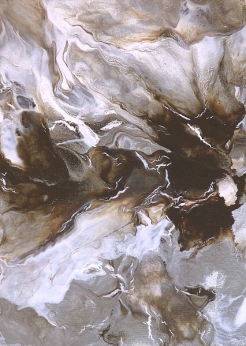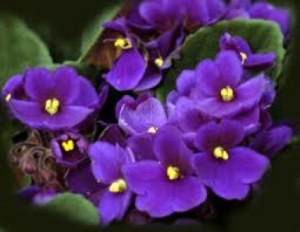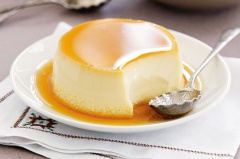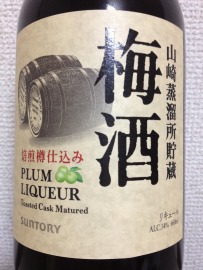A heady, rich, utterly opulent mix of creamy, white and yellow, tropical flowers whose velvety petals are infused with syrupy fruits and sprinkled with a touch of boozy liqueur, before being dipped in dark tea and bergamot, and then nestled in a vanilla cocoon. That’s the essence of Tom Ford‘s Champaca Absolute, a very lush eau de parfum that is part of his Private Blend line. The perfume was released in 2009, and is centered around the eponymous flower, Champaca, an Asian cousin to magnolia. Champaca has an aroma that is a mix of magnolia and ylang-ylang, but it can also have a tea-like aspect with fruited nuances. All those sides are highlighted in Champaca Absolute in a very bold, very sweet, very heavy mix that is not for the faint of heart.
Tom Ford’s description for the fragrance, as quoted by most retail sites, appears to be the following:
A floral oriental composition that is pure and provocative. With its sensuous heart of champaca, the magnolia-like flower that inspired it, this intoxicating nectar heightens the senses with notes of Tokajii wine and cognac as it warms the skin with vanilla bean, amber and sandalwood.
According to Luckyscent, the notes in Champaca Absolute include:
Tokaji [plum] wine, cognac, bergamot, magnolia champaca, orchid, violet, jasmine, vanilla, amber, sandalwood and marron glacé.
Fragrantica, however, has a slightly different list which is notable for the inclusion of dyer’s greenwood, a variety of the broom shrub that smells of hay. They state:
the top notes are cognac, bergamot and dyer’s greenweed [or broom]; middle notes are champaca, orchid, violet and jasmine; base notes are vanilla, amber, sandalwood and marron glace.
I think the complete, total list would be a combination of the two, as I definitely detect both the broom and the Japanese plum wine.
Champaca Absolute opens on my skin with an intense, concentrated blast of fruited, plummy, Japanese wine and cognac brandy, followed by tropical champaca. The flower smells of: buttery magnolia; custardy, banana-like ylang-ylang; apricots; and a heavy, syrupy, fruited sweetness. Lurking deep below the heady, over-the-top, floral richness is an almost leathered, smoky nuance. Sticky, cooked, plum molasses swirls in the floral air from the Japanese wine, while cognac is sprinkled all on top. You don’t smell as though you were dunked in a vat of alcohol, but there is a very pronounced liqueured aspect to the fruited sweetness.
I’ve noted a number of times in the past how Tom Ford fragrances can smell very different depending on how much you apply, and Champaca Absolute is no exception. When I applied a lot (amounting to a little over 1/3 of the vial, or the equivalent of 2 big sprays from an actual bottle), there was a definite vein of smoky darkness underlying the heady, sensual flowers. However, when I applied a lesser quantity (about 2 big smears, amounting to a small spray from a bottle), the notes which accompanied the champaca at the opening were quite different. There was no smokiness or leather, little plum, but a lot of orchid infused with vanilla.
Orchid has a very interesting, clear, sweet, delicate smell that can vary in its aroma depending on which variety of the flower is used. Here, in Champaca Absolute, it smelled delicately dewy, liquidy, and like floral nectar that was thoroughly infused with both ylang-ylang and vanilla. The overall effect was to remind me of one of my favorite, opulent florientals, LM Parfums‘ Sensual Orchid. It is a scent with a couple of notes in common with the Tom Ford, namely, orchid, boozy tonalities, ylang-ylang, jasmine, vanilla, and resins.
However, the two fragrances differ quite a bit in their focal points and overall feel. Champaca Absolute is dominated by the very unctuous, magnolia-like flower, not the lighter, clearer orchid. The Tom Ford fragrance feels more oriental, ambered, heavy, syrupy sweet, and fruited. In contrast, LM Parfums’ Sensual Orchid feels less flat on my skin, less potentially oppressive or weighed down, and much more purely floral. Its tropical touch comes from coconut, not from the custardy, buttery magnolia flower. It lacks bergamot, along with hay or tea tonalities, but includes mandarin orange, almonds, peony, and neroli. At the same time, its boozy note is substantially lighter and more refined. It’s also much fresher and less sweet at its core, and thereby, less potentially cloying in nature. I have to be honest, I much prefer Sensual Orchid’s take on the lush, over-the-top, narcotic, floriental genre.
Beyond the minor Sensual Orchid resemblance, a lower dosage of Champaca Absolute also yields other differences from the version I saw with a higher amount. The main difference is that the accompanying notes rise to the surface much sooner, particularly the bergamot, jasmine, and the broom’s hay-like note. There is a more obvious, profound, and long-lasting citrus tonality to the scent, along with increased dryness from the broom. There is also a stronger touch of earthiness in the base that verges on something like mushrooms or truffles, though it is subtle, so its impact is quite relative as a whole. (Still, it’s enough to make me think of Tom Ford‘s Black Orchid which has a truffle note in the base.) Apart from all that, and as noted above, Champaca Absolute does not feel resinous, smoky or dark at the lower dosage; and both the booziness and the fruity undertones are also much weaker. In short, if you apply less Champaca Absolute, you’ll get more of a sweetly floral-magnolia scent that has very different, very altered levels for the rest of its accompanying elements.
Regardless of the amount that you apply, both versions end up at the same place, sooner or later, so I’ll just stick with discussing the Champaca Absolute I experienced with the larger quantity. This version is fully centered on the magnolia-like flower, with not much interference from the orchid or anything else at first, other than the very fruity accords. The plum wine is powerful during the first 10 minutes, much more so than the boozy cognac on my skin, although both are simply different form of liqueured fruits. At the same time, there is a definite suggestion of something almost like Davana, a rich Indian flower that smells like apricot-y ylang-ylang. There is almost no fresh bergamot to lighten up the notes, no hay, and little vanilla.
10 minutes into its development, Champaca Absolute slowly shifts. The jasmine arrives on the scene, imparting an additional layer of syrupy sweetness to the bouquet. The plum wine takes a small step back, the boozy cognac softens a little, and the perfume feels even richer. There is the first hint of the champaca’s tea-like facet, along with the tiniest whisper of bergamot, though both are very muted at this point. Slowly, very slowly, Champaca Absolute turns more floral in focus. The boozy elements retreat to the sidelines after 30 minutes, and the delicate nectar of the orchid arrives to coat the richer, more unctuous, buttery champaca. There is a touch of broom now as well, but its subtle dryness does little to leaven or cut through Champaca Absolute’s richness.
In the base, there is a tiniest whisper of earthiness, though it never smells like marrons glacé or iced chestnuts to me. Interestingly, at the lower dosage, Champaca Absolute reflected a more noticeable, almost truffle-like, mushroomy nuance in its foundation, but it’s not so apparent now. By the same token, the tea-like elements and bergamot feel much weaker at the higher dosage, too. Frankly, the lighter, more minor notes have very little chance of standing up to the power of the heavy floral cocktail. Everything but the flowers, fruits, syrupy sweetness, and the growing touch of vanilla in the base are secondary — and, in some cases, tertiary, acting as a very muffled or muted suggestions at best.
The power of the florals as the showpiece is the main reason why Champaca Absolute doesn’t change much in the hours which follow. All that happens is that certain secondary notes fluctuate in their prominence, order, and clarity. Whether it is the bergamot, the tea, the darkly smoky aspect in the base, or the various fruits, they all basically reach a crescendo by the end of the 2nd hour. After that, they either lose their shape and individual distinction, melt into the base, or generally aren’t a main or powerful part of the scent.
The champaca (or davana-like) facets of apricot and tea have the greatest shelf-life in weaving about the top notes, along with the bergamot to a much lesser extent, but as a whole, Champaca Absolute is really just a floral blend of lush, tropical, velvety flowers dominated by a magnolia-like richness. It is infused with vanilla which increasingly takes over from the fruited elements. They, in turn, become more abstract, feeling merely like a general fruity syrupiness that coats all the flowers.
The more obvious, significant changes to Champaca Absolute involve its projection and feel. Initially, the perfume was very potent, powerful, and intense — regardless of how much you apply. However, with a little over 1/3 of a ml or about 2 sprays from a bottle, Champaca Absolute is extremely forceful indeed. At first. In fact, it’s rather a surprise how quickly the perfume turns soft and the sillage drops. I suspect Tom Ford sought to counterbalance the richness and sweetness of the notes with something that was less dense in weight. If so, then he succeeded in that goal. At the end of the first hour, Champaca Absolute turns softer and weaker. From an initial distance of about 5-6 inches, the perfume’s projection now drops to around 2-3 inches. At the end of the second hour, however, Champaca Absolute hovers just above the skin. And that’s at the very high dose! Granted, it remains there for hours, and only turns into a discreet skin scent at the 6.5 hour mark, but given the serious intensity of the opening moments, I was a little surprised by soft and airy the fragrance becomes later on.
By the end of the 2nd hour, Champaca Absolute is a well-blended, seamless blend of lush, tropical, buttery flowers dominated by a magnolia-like richness that is lightly flecked with jasmine syrup, hints of ylang-ylang, and a touch of Davana. Tiny streaks of apricots, dark tea, and, to a much lesser extent, fresh bergamot run through it. There is no hay, earthiness, plum, or booziness on my skin. There continues to be a definite element of fruitiness, but it becomes increasingly abstract and indistinguishable from the florals. Only the tiniest suggestion of a dark, slightly smoky, resinous amber ripples through the base. Much more prominent, however, is a smooth, custardy creaminess that has a very vanillic nature.
In the hours that follow, Champaca Absolute turns into a simple blur of rich florals with tropical creaminess. As noted above, the other notes either fade into the sidelines, or melt completely into the base. The resinous amber, smokiness, and bergamot are the first to vanish around the 5th hour. After that, the apricots and fruitiness. Late in the 6th hour, Champaca Absolute is primarily a sweet floral with a custardy, banana-like richness and sweetness. If I smell very hard with my nose right on the skin and focus intently, I can single out ylang-ylang and jasmine as the most prominent aspects, along with vanilla and a subtle hint of fruitiness. There is a brief flicker of some nebulous, vaguely woody note in the base, but it’s hardly distinguishable as sandalwood. (And it’s most definitely not Mysore sandalwood.)
From afar, though, Champaca Absolute is a mere haze of rich, custardy florals, and it remains that way until its very end. In its final moments, the perfume is a light smear of floral sweetness with a suggestion of something creamy, tropical and fruited about it. All in all, Champaca Absolute lasted under12 hours with a small amount, and a whopping 14.75 hours at a higher dosage. Given how my skin eats up perfumes, that says something. The sillage hovered just above the skin for a good portion of that time, and the perfume felt quite airy in weight, despite the heaviness of its notes up close.
I’m going to say this bluntly, and probably about 15 more times during the remainder of this review, but Tom Ford’s Champaca Absolute is one of those love it/hate it scents that you should not go anywhere near if you don’t love extremely heavy, lush, sweet florals. If you hate the richness of magnolia, stay away. If you can’t bear the sweet syrupy aspects to jasmine, or the custard heaviness of ylang-ylang, stay away. If you don’t like even light amounts of hay, broom, or earthy notes, you may want to pause. If you don’t like intensely fruited notes, especially very unctuous, syrupy, or tropical fruited notes, then run. Same thing if you don’t like fragrances with even light touches of booziness or liqueured aspects. And if you hate fragrances that explode like a heavy, powerful bomb at the start, then you may want to go to the other end of the planet than anywhere which is wafting Champaca Absolute. This is a fragrance for a very particular sort of perfume taste, and it will not be for everyone. I cannot emphasize that enough.
Now, if you happen to be someone whose taste or perfume style suits several of the aforementioned categories — ideally, all of them — then you may find Champaca Absolute to be the best thing ever. However, even if you are one of those people, there is a chance that Champaca Absolute will feel too heavily and oppressive in its flat, dense, richness. I happen to be someone who actually is in the target demographic, and I’m still a little uncertain about the perfume.
I enjoy Champaca Absolute’s opulence and richness, but I really have to pause at times. For one thing, the perfume is a little too monolithic in its feel. If Champaca Absolute didn’t drive over you like a Panzer unit on its way to Poland, then I might handle it better. If the linearity of “heavy florals with vanilla” had been leavened with more changes, I might not feel quite so exhausted by the end. I think it’s a great scent for a “once in a while” occasion, in low quantities; I’m not sure about anything more than that, or about wearing Champaca Absolute on a frequent basis, let alone a daily one. There is something about the scent that feels as though you just ate 6 whole vanilla-frosted cakes, when you merely asked for a single, large slice. Wearing Champaca Absolute for a few days in a row would probably put me off both cake and rich florals for a while.
I suspect that some (or many) of these issues are the reason why Champaca Absolute has received mixed reviews. In fact, on MakeupAlley, the fragrance seems to be quite polarizing. Take this long (edited) assessment by “Mac789” who seemed to initially like the fragrance, before drastically changing her mind:
A wonderful, bitchy-pill white floral that completely disagreed with me. […][¶]
This is not your mother’s white floral, nor is it something that is especially easy to wear. It’s a ballsy scent with a lot going on and it has extreme lasting power.
The drunken spree at the top, combined with the champaca absolute, a sprig of almost mentholated green, and whatever other floral is veering around, blew my mind. Nothing smells like this. Thank you, Tom Ford, for creating a five-alarm fragrance. The florals are rich, bright, and careering towards instability.
Shortly, a strong honeyed broom note appeared. I have never liked broom, although I can’t fault the fragrance for its use. […][¶] I then left the store and let the fragrance air out. Within short order, the base ripped through. This base was fanatical woods and dirt, insistently growing and engulfing, sharpening, smothering, cutting… reaching a splintering zenith from which there was no escape, not by washcloth, shower, or baby wipe…
It stayed with me until the next day, showing off. The experience left me reeling, and also realizing that sometimes the thing that stands out the most is the thing that most attracts–for the wrong reasons.
Champaca Absolute is a standout that I suspect will entrance and enchant people who adore broom, woods, and soil. It’s a highly creative fragrance [… but it] was too distorted for me to wear, with both giant opener and closer and not a smooth segue from one thing to the next, or perhaps it was my perception that was distorted, since I liked it well enough when I first smelled it. As of right now, though, rather than being that overworked term “edgy,” it pushed me towards the edge.
Others had a very different experience, where the problem was not any earthiness or broom at all, but rather “putrid fruit,” too much tropicality, or just plain fatigue after a while. Some of the shorter responses:
- This has a problem of arrested development on my skin. No matter how much I spray, it is arrested at a preliminary stage where it is about to bloom and that is it. I also get cognac-sweet top notes but the rest is just a super humid tropical evening without much in particular. Indeed Champaca Abcolute has such a humid, moist vibe on my skin that it wouldn’t surprise me if I started seeing tiny mushrooms popping up on my skin. It also turns acrid, somehow fermented on my skin after a short while. [¶] Still, even I get a meaty tropical flower smell from this. Is it champaca? […] I get something that makes me think of magnolias and other things.
- Its an alright fragrance. At first whiff this was gorgeous and I had to have it but the drydown was not something that I liked as much. Too floral for me.
- It was really perfume intensity and smelled like putrid fruit. Not like a big white floral that I was hoping for. […] The next day I could still smell it on my skin. It finally had become pleasant, but nothing special.
Others, however, love Champaca Absolute, sometimes passionately so:
- [At] the Tom Ford counter […] I tried White Musk (my least favorite), Oud Wood (too masculine), Japon Noir, Noir de Noir (not too bad), but none of them really blew me away until I smelled Champaca Absolute! This fragrance is mysterious, sensual, sweet and surprising. Everything that I was looking for. [¶] The cognac top note really makes this a special fragrance. The sweetness lasts about an hour and then comes the Jasmine, Violet, Orchid and Champaca floral notes. Very nice. The dry down is especially wonderful. The fragrance stays close to your skin all day. I really think this is a timeless fragrance that’s good for any adult age.
- How lovely! TF Champaca Absolute opens with blast of champaca-scented rice in a container made of fresh-cut bamboo-stem, along with sweet ripe plum. I am a big fan of white florals and I love the real champaca flower. The name is misleading as champaca is never dominant but lingers to the end. [¶] Comparision between TF Champaca Absolute and Ormande Jayne Champaca: OJ is “browner” and denser while TF is greener and more airy. OJ is less sweet and less rice-like. Both are well-blended exotic beauties! OJ is “wilder” while TF is more lady-like. I like both.
- TF Champaca Absolute by **no means** deserves any kind of low rating or to be compared to Ormonde Jayne et al. Tom Ford went to the most ancient of gardens, where perfumiers have been harvesting for thousands of years, and has captured not just the scent, but the **soul** of champaca (hence the “absolute.”) If it turns putrid as some say, then that’s incompatible skin chemistry my dears, NOT the perfume. When a perfume turns putrid after being sprayed on acid-free paper or linen, then and then only can it be considered a loser. TF Champaca Absolute is EXQUISITE to the extreme, and incredibly lifting, not only for the wearer, but those who experience the waft. […] Tom Ford has nailed it. That is **exactly** what champaca is… a sacred flower that the eastern cultures maintain inspires a higher peace and joy. [Emphasis to names with bolding added by me.]
I’ve spent so much time on the average perfumistas’ mixed responses to Champaca Absolute in order to provide a counterbalance to the bloggers who generally seem to love the fragrance and who also detect very different elements. Take, for example, Victoria at Bois de Jasmin who wrote:
Despite its name, Champaca Absolute is not a soliflore—the magnolia note is part of a bouquet. Overall, it is a quite a striking blend, full of character and dramatic presence. Like many Private Blends, Champaca Absolute has a certain vintage glamour, yet without a self-conscious retro aesthetic. The richness of the composition is evident throughout: from the top accord, with its dried fruit and candied citrus nuances, to the sugared amber and vanilla base. Set against this gourmand cornucopia is a heady, luxurious floral composition. It suggests the indolic heft of jasmine, the spicy warmth of carnation and the petally radiance of magnolia. While magnolia is only an accent, it fits so beautifully that I forget about wanting a magnolia soliflore experience.
There is a point to the development of Champaca Absolute that reminds me strongly of Tom Ford Black Orchid, or rather what I wanted Black Orchid to be—an unapologetically rich, opulent floral. The late drydown of Champaca Absolute is my favorite part. The dramatic sensuality of the composition mellows down, leaving one with an intimate, warm veil of woods, incense and violets. It is certainly worth waiting for!
Then, there is The Non-Blonde who also seems to have thoroughly enjoyed the scent:
Is Champaca Absolute the big fruity floral in Tom Ford’s Private Blend line? Yes and no, I guess. The floral heart notes take center stage and they are accentuated with sweet round plums and a plum liqueur. But, really, this is not something that belongs in a pink bottle on Sephora’s shelves. The first blast is very alcoholic and boozy. Something between Armagnac and a plum brandy. […] Champaca Absolute smells really really good.
The flowers (jasmine, violet, orchid, champaca) are blended into a single accord of prettiness.It leans to the tropic side, a little loud and exuberant, but after wearing it enough times and learning to listen I’ve begun to smell the softness that lies underneath. It feels like a layer of silk, not quite powdery and not quite sweet- I guess that’s the steamed rice quality of champaca. I have yet to find it when wearing Ormonde Jayne’s Champaca which I like well enough, but Tom Ford’s version works better on my skin for one reason or another.
Maybe it’s the base. Champaca Absolute dries down rich and sweet. After four or five hours it becomes a full blown oriental, even though the floral accord is tenacious enough to still be hover and appear here and there, especially in the heat. I can’t say I get the promised marron glace note, but there is quite a bit of sweet creaminess to satisfy my sweet tooth. [Emphasis and bolding to name added by me.]
On Fragrantica, the reviews are as mixed as they are on MakeupAlley, though a substantially greater number seem to really like Champaca Absolute. Some find the perfume to be a wonderful successor to the tradition of big ’80s powerhouses, or even older ones like Fracas. A handful enjoyed the beginning before being overwhelmed by too much syrupy sweetness over the course of the perfume’s development, and changing their mind. Several dislike Champaca Absolute as being “too perfume-y,” too much like “an old lady perfume,” or too boring in its simple floral nature. Others rave about how it is “seductive,” “glorious,” “exceptional,” their “favorite TF buy so far,” or even their “favorite fragrance of all time.”
Interestingly, one of the positive reviews comes from a man. Actually, I know a few men who enjoy Champaca Absolute, probably because of boozy opening, but they are exceptions as this is a fragrance that definitely skews feminine in nature. Still, you may be interested in one man’s Fragrantica assessment:
Champaca Absolute is my favourite TF and in my opinion one of his best.Boozy opening,no doubt,but once the cognac has subsided to a lesser extent the glorious chestnut aroma remains right through the mid notes and drydown. I disagree with previous commentary that its a female only scent and an old womans fragrance or overtly floral. For mine the floral notes are there but take a backseat.Granted its not the most masculine scent going around but its a standout in a bland sea of citrus/aquatics/oriental/woods and can be worn by a guy who is looking for something totally unique and is confident enough to wear it. Longevity is in the vicinity of 6 hours and sillage is close to the skin.
Definitely worth a sample and pleased I have added this gem to my collection of niches 🙂
Whether or not a man can wear Champaca Absolute is definitely going to depend on his personal tastes and comfort zone. I firmly believe that if you feel good in what you’re wearing, that’s all that matters. So if a guy enjoys lushly opulent, boozy florals, then Champaca Absolute is definitely one to consider. If, that is, he fits within all my prior parameters or warnings about both the scent as a whole and its particular notes.
We all have different perfume tastes, and there isn’t a scent in the world which is going to appeal to everyone. Tom Ford’s fragrances tend to be more polarizing in general, due to their intensity, richness, often powerhouse forcefulness, and heaviness. Champaca Absolute is no different. However, it may be a little more of a love it/leave it scent than some of his others. I’ve noticed that people really respond at opposite ends of the spectrum to big, lush, heavy florals. Here, there is the added issue of syrupy sweetness, almost tropical fruitiness, and the other supporting notes like the cognac, broom, and the very subtle earthiness. Making matters even more complicated is that lush intensity, the heaviness, and an 80s-like powerhouse strength. If all of that sounds like your cup of tea, then you should definitely seek out Champaca Absolute. You may want to remember, however, that — just like a very rich cake — a little goes a long way.












































































